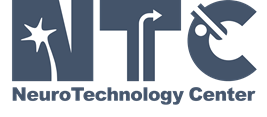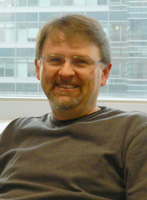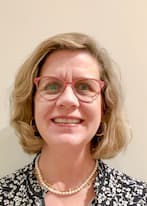Neurotechnology Center
Anschutz Medical Campus

NTC Mission
The NeuroTechnology Center (NTC) at CU-Anschutz is a partnership between the University of Colorado School of Medicine and member Departments with significant interests in neuroscience research. The missions of the NTC are:
- To support core facilities that provide School of Medicine investigators access to key, cutting-edge technologies that are essential for neuroscience research at CU Anschutz.
- To work with School of Medicine departments to jointly recruit additional neuroscience-focused faculty to CU Anschutz who emphasize development and application of novel technologies, with a goal of building strong collaborative, cross-disciplinary research teams.
About the NTC
The overarching idea behind the NTC is that novel technologies have revolutionized how we study the nervous system, all the way from the molecular to the in vivo/systems level, and our core facilities and faculty should be at the cutting-edge of developing and implement novel technologies to advance our understanding of the nervous system and to develop new treatments for nervous system disorders.
The NTC also engages in educational and outreach activities by hosting/co-hosting and administering research seminars, retreats, and symposia in partnership with the Neuroscience Graduate Program, the Rocky Mountain Neuroscience Group, and the NSF-funded Rocky Wearable Microscopes Summit. In addition, the NTC is a sponsor of the Summer Research Training Program and a supporter of the NINDS-funded BRAiN summer research program that provide research internships on the campus for undergraduate students from groups historically underrepresented in science.
NTC Membership
NTC membership is defined at the Department level, with Departments joining the NTC by participating in joint recruitment of neurotechnology-focused faculty with the NTC. These NTC recruitments are envisioned as collaborative, interdisciplinary, and possibly interdepartmental; allowing recruitment of neurotechnology-focused researchers across disciplines. In return, researchers in NTC member Departments are eligible for discounted user fees for the NTC cores. Current NTC member Departments span multiple basic science and clinical disciplines.
NTC Cores
Meet the Director
Dr. Mark Dell’Acqua, PhD, Professor and Vice-Chair of Pharmacology
2022-2023 NTC Highlights
Working with the Department of Pharmacology, the NTC recently completed a joint faculty recruitment of Dr. Justin O’Hare, PhD, a postdoctoral fellow and K99/R00 awardee from Columbia University. Dr. O’Hare, is a neuroscientist whose research program employs a cutting-edge combination of electrophysiological recording, fluorescence imaging, and behavioral monitoring to study neuronal dendritic calcium signaling dynamics during behavior time-scale synaptic plasticity that underlies hippocampal place cell formation during spatial learning and memory. Justin is currently a visiting postdoctoral scholar at Stanford University and will join the Department of Pharmacology as an Assistant Professor in Summer 2024 when his K99 fellowship ends.
Advanced Light Microscopy (ALMC) Core Highlights
-Total usage of the core: 5394 hours-Total number of laboratories that have used the core: 114
-Number of new users of the core: 137
-Number of papers published that used the core instruments: 12
-New microscope purchased: Infinity STED microscope by Abberior, arriving next fiscal year
-Submitted NIH S10 grant for new Zeiss LSM980 2P/confocal FLIM to replace Zeiss LSM780
Optogenetics and Neural Engineering (ONE) Core Highlights
- Worked with 30 different research laboratories on 32 projects.Project highlights:
-Developed a novel system for precise control of behavior experiments, including delivery of light, sound, and foot shock while simultaneously acquiring time-stamped videos.
-Designed system for detecting the force of a mouse licking a water droplet.
-Engineered and fabricated novel experimental equipment, including well plate bifurcation chambers and a rotational anesthesia delivery system for rodents.
-Obtained new equipment to expand capabilities for user projects, including high-performance computers for data analysis and a dual extruder, high volume 3D printer.
Innovation and Design for Experimentation and Analysis (IDEA) Core Highlights
- Worked with 12 users in 8 research laboratories.Project highlights:
-Food Pellet Delivery System - Capable of 3-axis positioning with a mechanically stable, compact design, Home Cage Trainer - Automated training of autonomously head-fixed mice
-Head-fixed Wheel - A head-fixed mouse runs on a transparent wheel for 3D video recording
-Animal Behavior Core: Fear Conditioning - One computer manages four behavior chambers for fear conditioning in mice
-Deep Brain Stimulation (DBS) OCD Monitor - A touchscreen-based GUI and apparatus for imaging patients in an outpatient clinic with chronic DBS implants
-DBS OR Monitor - A GUI and apparatus for imaging patients undergoing acute DBS in the operating room
-Organ Perfusion Chamber - Platform for culturing and perfusing explanted murine blood vessels
-Pup Clamp - Platform for positioning young mouse pups in preparation for brain stem injections
Neuroscience Machine Shop Highlights
- Worked on over 120 projects from 43 research laboratories.- Overall, these projects included featured novel fabrication of research equipment from large scale acoustic isolation chambers and olfactometers to very small GRIN Lens/Mini-scope Adapters. Additionally, the shop offered maintenance of existing equipment, and repair projects for damaged equipment and animal enclosures.
Project highlights:
-Prototyped a mouse treadmill compatible with microscopy.
-Worked to patent a novel needle bending device designed and created in the shop for gastrointestinal surgery.
-Expanded our capabilities by adding updated equipment (Laser cutter, Advanced 3-axis CNC Control, and 5-axis Micro-Mill) to complete more sophisticated parts and difficult geometries.
Animal Behavior Core (ABC) Highlights
-Helped research teams design, plan, and perform long-term and short-term behavioral studies.-Coordinated the move to the new AHSB vivarium space, increasing the number of testing rooms from 5 to 11 (6 mouse rooms, 4 rat rooms, 1 zebrafish).
-Worked with IDEA and Machine Shop cores to implement duplicates of tasks in the new space (Fear conditioning, Open Field…)
-Instituted new behavioral testing paradigms (Optomotor Visual Response, Porsolt Forced Swim Test)
-Total number of laboratories that used the ABC: 28
-Departments/divisions served: 13
-6 published papers plus 3 papers submitted.
In Vivo Neurophysiology Core (IVNC) Highlights
-Coordinated the move to the new AHSB vivarium space and set up EEG recordings for mice and rats in 2 new rooms. -Total number of laboratories that used the IVNC: 5
-Departments/divisions served: 7

